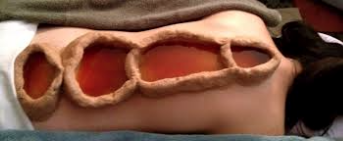Spine Care
Each segment of the spine is crucial to the well being of the entire spinal column and cord since the strength of each portion is contingent upon the other vertebrae and discs to function properly. Through time, the spine may be subjected to constant stress, repetitive or high impact injuries, diseases, and arthritis. These conditions can cause pain, degeneration, and lack of function.

Ankylosing Spondylitis
Ankylosing Spondylitis (AS) is a form of progressive arthritis that creates chronic inflammation of the spine and sacroiliac joints, the two joints that connect the spine and the pelvis. Initially, inflammation occurs in the sacroiliac joints then progresses to the spine, causing stiffening and restricted movement. With long-term inflammation of the spinal joints (spondylitis), calcium deposits form in the ligaments around the invertebral discs that cushion the vertebrae and in the ligaments that hold the vertebrae together. As the ligaments calcify, movement and flexibility become severely impaired. The disease can progress to the point of fusing the vertebrae together which is known as “ankylosis.” As a result of AS, the vertebrae become brittle causing the spine to loose mobility and be receptive to fractures. AS is a systemic disease that not only affects the joints, spinal ligaments and bones, but also the body’s organs.
Arthritis
Inflammation of a joint, usually accompanied by pain, swelling, and stiffness, resulting from infection, trauma, degenerative changes, metabolic disturbances, or other causes.
Bulging Disc
Bulging discs are not uncommon, and frequently are displayed on MRIs as an abnormality for both young and older adults. Having a bulging disc is not necessarily a serious concern, and it may not even cause back pain. Bulging most likely happens as the body ages and degeneration of the intervertebral disc occurs. A bulging disk is formed when the soft, spongy center of the disk, the nucleus pulposus, pushes out and places pressure on the outer surrounding fibrous ligament, the annulus fibrosis that contains the center. Unlike a herniated disc, the bulging disc still contains the nucleus material.
Cervical Arthroplasty

In treating cervical disc degeneration, treatments are often limited to decompression, correction of deformity, or stabilization of the spine. With the exception of decompression, procedures such as these require fusion, which immobilizes the spinal segments that are fused. Cervical Arthroplasty is a break-through procedure which involves disc replacement, restoring range of motion and offering a significant treatment toward spinal pain.
Degenerative Disc Disease
Over time, the spine can be stressed with daily motion and minor injuries that eventually create wear and tear on the intervertebral discs causing them to degenerate. The discs are designed similar to shock absorbers to handle pressure and impact, as well as act as a cushion during the body’s movement to keep the spine flexible. Their role is vital to preserving the vertebrae, as bones cannot sustain repeated stress without becoming damaged.
In a healthy intervertebral disc, the soft, spongy center known as the nucleus pulposus contains a high level of water content allowing it to absorb stress. When excessive pressure or impact is incurred by the disc, the annulus (the tough outer ligament material that surrounds the nucleus and supports the vertebrae), is often the first portion of the disc to exhibit damage. Small tears in the ligament material are replaced with scar tissue as the body tries to heal itself. However, the scar tissue is not as strong as ligament and weakens the annulus. As the outer layer degenerates, the nucleus pulposus begins to loose water causing it to dry up.
Due to water loss, the disc looses its capability to absorb stress and act as a cushion for spinal flexibility. This situation creates added stress, and the damage cycle becomes repetitive further tearing the annulus and causing the nucleus to collapse. As the disc compresses, the space between the vertebrae above and below it narrow. As the area becomes constricted, the facet joint, located at the back of the spine, can move out of position rendering the joint less operable.
In addition to the lack of joint facilitation, bone spurs known as osteophytes may form around the disc space and the facet joint as the body’s response to impede excessive motion to the damaged area of the spine. The bone spurs can impair the spine if they grow into the spinal canal and press on the spinal cord and nerves. This condition is known as spinal stenosis.
Facet Disease
The Facet joints are the joint structures that connect the vertebrae to one another. The facet joint is like any other joint in your body – they have cartilage that line the joint, (this allows the bone to glide smoothly over one another) and a capsule surrounding the joint. The function of the facet joint is to provide support, stability, and mobility to the vertebrae (spine). Facet Disease occurs when there is degeneration of the facet joint.
Foraminal Stenosis
Foraminal stenosis is a narrowing of the spinal foramen, the hole through which passes a spinal nerve as it exits the spine (foramen basically just means “hole”). It is usually a form of degenerative spine disease which occurs slowly over time with wear and tear of the spinal column. Arthritic changes of the spine, including herniated discs and bulging discs, soft tissue swelling and bony growth can all impinge on the formal foramen and compress the nerve within.
Herniated Disc

Disk herniation is a rupture of fibrocartilagenous material (annulus fibrosis) that surrounds the intervertebral disk. This rupture involves the release of the disk’s center portion containing a gelatinous substance called the nucleus pulposus. Pressure from the vertebrae above and below may cause the nucleus pulposus to be forced outward, placing pressure on a spinal nerve and causing considerable pain and damage to the nerve. This condition most frequently occurs in the lumbar region and is also commonly called herniated nucleus pulposus, prolapsed disk, ruptured intervertebral disk, or slipped disk.
Pinched Nerve
A pinched nerve occurs when too much pressure is applied to a nerve by surrounding tissues — such as bones, cartilage, muscles or tendons. This pressure disrupts the nerve’s function, causing pain, tingling, numbness or weakness.
Spinal Stenosis
Spinal stenosis is any narrowing of the spinal canal that causes compression of the spinal nerve cord. Spinal stenosis causes pain and may cause loss of some body functions.
Sciatica
Sciatica refers to pain or discomfort associated with the sciatic nerve. This nerve runs from the lower part of the spinal cord, down the back of the leg, to the foot. Injury to or pressure on the sciatic nerve can cause the characteristic pain of sciatica: a sharp or burning pain that radiates from the lower back or hip, possibly following the path of the sciatic nerve to the foot.
Spondylosis
A degenerative disease of the spinal column, especially one leading to fusion and immobilization of the vertebral bones. Also considered arthritis of the spine.
Spinal Fractures
The spinal bones have great strength, but like other bones in the body, they can fracture under circumstances that involve too much pressure, trauma or disease. When a spinal bone fractures it is known as a vertebral compression fracture. These types of fractures occur most often in the thoracic (middle portion) of the spine in the lower vertebrae.
A normal bone can handle a great amount of pressure and with the spine’s flexibility it can bend to absorb stress, however if a bone weakens, the force becomes too great for the bone to sustain it. Intense pressure, physical injury or trauma can lead to minor or severe fractures. Trauma such as a fall, hard jump or impact from a car accident may stress the spine past its breaking point causing one or more of the vertebrae to crack or break apart.
Osteoporosis, a disease that thins the bones can also weaken the vertebrae until they are unable to withstand pressure causing them to collapse. Spinal compression fractures are the most common type of osteoporotic fractures, besides the hip and wrist bones. These vertebral fractures can permanently alter the shape and strength of the spine, especially in elderly women who are more susceptible after hormone loss to losing weight and having spinal deformity. The spine may appear like a humped back where the shoulders fall forward and the top of the back looks enlarged. This disorder is referred to as “kyphosis.” In severe cases of osteoporosis, simple movements such as bending forward can create a crush or compression fracture.
TRETMENT
IN AYURVEDA THERE ARE SEVARALSPECIFIC AND BROAD LINE OF TREATMENT FOR EACH DISC PROBLEM MOST COMMANLY WE USE TO CURE SPINE DISORDERS ARE:
- 1.VIRECHANA
- 2.MADHUYESTIKSHEERAPAKA BASTI (KALA BASTI)
- 3.KATI BASTI
- 4.GREEVA BASTI
- 5.PRUSTA BASTI
- 6.PATRA PINDA SWEDA
- 7.THULODUL & THUMBING
For further details please contact : 23505777, 9341226614

